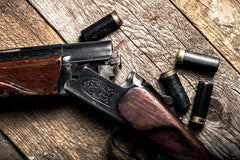Buying a Child’s First Shotgun

It’s a moment that many hunters remember fondly: the day they got the first shotgun they could call their very own.
Maybe it was a hand-me-down model from an older sibling, or maybe it was a new piece that was scaled down to fit better in small hands. Either way, it’s something that generations of hunters have enjoyed with their own children, passing down their own love of shooting sports to the next generation.
But, for far too many people, this memory is colored by another, less pleasant, recollection.
Consider the all-too-common scenario from “back in the day,” when kids were often handed whatever shotgun was available and had to adjust their own skillset to a weapon that was far too large and powerful for them. As a result, the learning curve in those days was very steep. Trouble is, early shooting habits are hard to unlearn later in life, so many hunters, even today, struggle with bad shooting form that they developed on day one with an oversized shotgun.
As Larry Case writes:
“Now let’s see, you give a kid a shotgun that doesn’t fit, it is too big and too heavy, the recoil of which could make a grown man cry. Do we see a problem here? Friends, bad shooting habits can follow us for a lifetime; sometimes it is not our fault. The kid who was forced to shoot Uncle Bill’s Model 97 will never forget that it kicked like the proverbial mule. He developed a flinch that day, which may very well follow him to the grave.”
Too much gun for small hands
The truth is, seasoned hunters often forget the issues that tend to plague novice shooters: strong recoil and general fatigue.
A shotgun with a high level of recoil can be very uncomfortable for a child, especially when they are shooting a gun that is not a good fit for them. It’s like getting punched in the shoulder and the wrists over and over again, and it hurts when you haven’t yet developed the strength to properly control it.
Fatigue is another common complaint when kids are shooting a gun that is too big from them. Without a proper gun fit, the novice hunter is left struggling with grips that are too big and a shotgun that is just too long and heavy for them to comfortably control, resulting in a physical struggle that tires them out and can be very frustrating.
Consider the options
Fortunately, there are a number of youth-sized shotguns available on the market with a range of features and options for children. Keep these considerations in mind when shopping:
Weight: As a general rule, pump shotguns are lighter than auto loaders and are easier for small hands to operate. If your child isn’t comfortable holding the gun in a resting position and struggles to swing it into position, it’s too much gun for them to shoot accurately.
Adjustability: Many youth oriented pump-action shotguns, such as the Remington 870 Compact Jr., can be adjusted as the shooter grows to allow them to get more use out of the weapon. The Remington, for example, features a 12-inch pull that’s designed for small shooters, but can be adjusted up as they grow.
Shells: A training weapon is about more than just the shotgun itself. The practice period also needs to include sessions with lightly loaded shells that help to minimize kickback and recoil. Once they’ve practiced with these and feel comfortable with and in control of their weapon, they can move up to standard shells.
Of course, as with everything for kids, outgrowing these smaller weapons is a very real possibility—as anyone who has ever tried to keep a couple of growing kids outfitted with skis knows all too well—but the important thing to remember is that it’s better to get a shotgun that fits your child now versus one that they will grow into over time.
“While you are waiting for them to grow into this gun, how many bad days in the field will they have and how many bad habits will they acquire because of a shotgun that is too big and heavy for them?”
